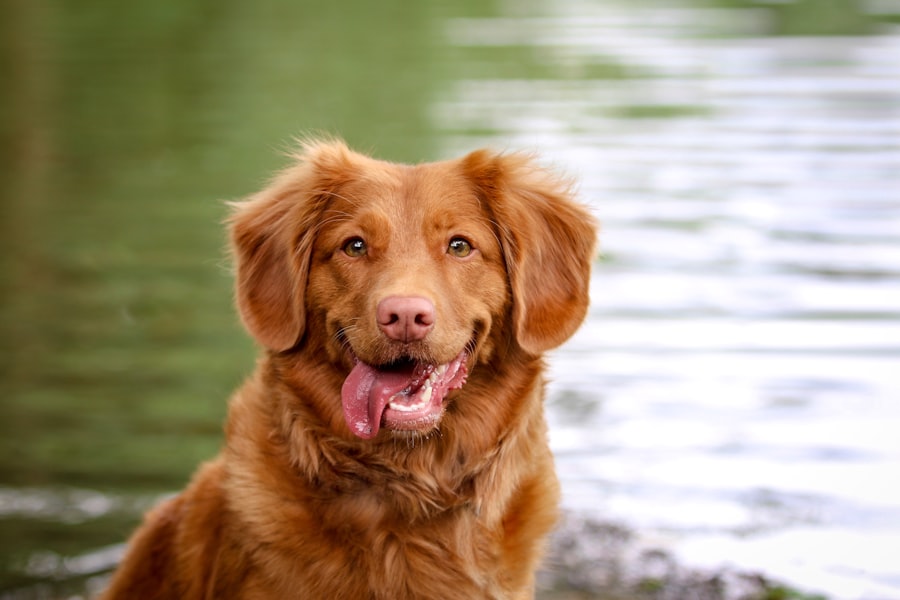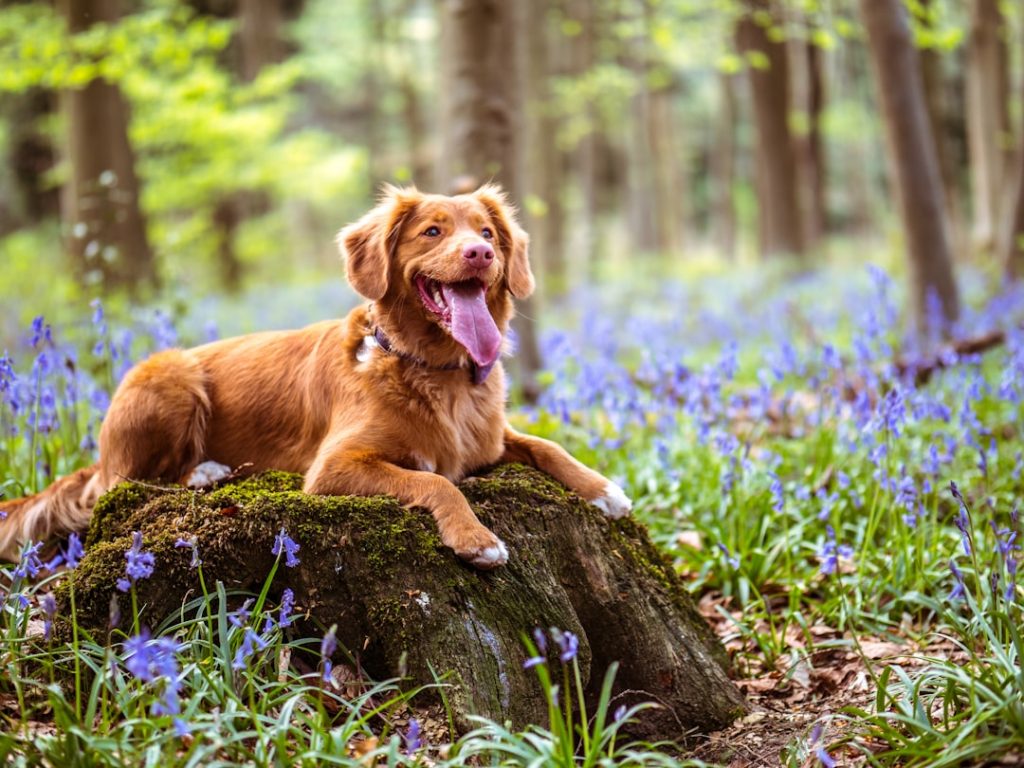The Nova Scotia Duck Tolling Retriever, also known as the Toller, is a medium-sized breed that originated in the early 19th century in the Little River District of Nova Scotia, Canada. The breed was developed to toll, lure, and retrieve waterfowl, hence the name “tolling retriever.” The Toller is the smallest of the retriever breeds and is known for its distinctive red coat and fox-like appearance. The breed’s exact origins are not well-documented, but it is believed to have been developed from a mix of retrievers, spaniels, and possibly collies. The Toller was recognized by the Canadian Kennel Club in 1945 and by the American Kennel Club in 2003.
The Nova Scotia Duck Tolling Retriever’s history is closely tied to the sport of duck hunting. The breed was developed to work alongside hunters, luring ducks within gunshot range by playing and frolicking along the shoreline. Once the ducks were within range, the Toller would retrieve them from the water. This unique hunting method earned the breed the nickname “the decoy dog.” Over time, the Toller’s skills and abilities were recognized beyond hunting, and it became a popular companion and show dog. Today, the Nova Scotia Duck Tolling Retriever is still used for hunting and retrieving, but it is also valued as a family pet and versatile working dog.
Table of Contents
- 1 Physical Characteristics and Appearance of the Nova Scotia Duck Tolling Retriever
- 2 Temperament and Personality Traits of the Nova Scotia Duck Tolling Retriever
- 3 Training and Exercise Needs for the Nova Scotia Duck Tolling Retriever
- 4 Health and Grooming Requirements of the Nova Scotia Duck Tolling Retriever
- 5 Living with a Nova Scotia Duck Tolling Retriever: Considerations for Prospective Owners
- 6 Activities and Sports for the Nova Scotia Duck Tolling Retriever
- 7 FAQs
- 7.1 What is a Nova Scotia Duck Tolling Retriever?
- 7.2 What are the physical characteristics of a Nova Scotia Duck Tolling Retriever?
- 7.3 What is the temperament of a Nova Scotia Duck Tolling Retriever?
- 7.4 What are some common health issues in Nova Scotia Duck Tolling Retrievers?
- 7.5 What are some activities that Nova Scotia Duck Tolling Retrievers enjoy?
Key Takeaways
- The Nova Scotia Duck Tolling Retriever originated in the early 19th century in Nova Scotia, Canada, where they were bred to lure and retrieve waterfowl.
- This breed is known for its medium-sized, muscular build, with a dense double coat that comes in various shades of red and orange.
- Nova Scotia Duck Tolling Retrievers are intelligent, affectionate, and energetic dogs, making them great companions for active individuals or families.
- Training and regular exercise are essential for this breed to keep them mentally and physically stimulated.
- Health concerns for Nova Scotia Duck Tolling Retrievers include hip dysplasia, progressive retinal atrophy, and autoimmune disorders, while grooming involves regular brushing and occasional baths to maintain their coat.
Physical Characteristics and Appearance of the Nova Scotia Duck Tolling Retriever
The Nova Scotia Duck Tolling Retriever is a medium-sized, muscular dog with a compact and balanced build. The breed’s most distinctive feature is its deep red coat, which can range from a golden red to a dark coppery red. The Toller’s coat is water-repellent and consists of a soft, dense undercoat and a longer, straight outer coat. The breed’s tail is long and bushy, often carried high and wagging enthusiastically when the dog is excited. The Toller’s head is slightly wedge-shaped, with a moderate stop and a strong muzzle. The breed’s eyes are medium-sized, almond-shaped, and usually dark brown in color.
The Toller’s overall appearance is that of a agile and athletic dog with a fox-like expression. The breed’s medium-length ears are triangular and set high on the head, framing the face. The Toller’s legs are straight and muscular, with compact feet and webbed toes that make them excellent swimmers. The breed’s gait is smooth and efficient, reflecting its ability to move quickly and gracefully. Overall, the Nova Scotia Duck Tolling Retriever presents a striking and elegant appearance that reflects its heritage as a skilled working retriever.
Temperament and Personality Traits of the Nova Scotia Duck Tolling Retriever
The Nova Scotia Duck Tolling Retriever is known for its friendly, outgoing, and intelligent nature. Tollers are highly energetic dogs with a playful and mischievous streak, making them a joy to be around. They are affectionate and loyal towards their families, often forming strong bonds with their owners. Tollers are also known for their alertness and keen sense of observation, making them excellent watchdogs. They are quick to bark at unfamiliar sights or sounds, making them an effective early warning system.
Tollers are also highly trainable and eager to please, making them well-suited for various dog sports and activities. They excel in obedience, agility, flyball, and dock diving, among others. Their intelligence and willingness to learn make them a versatile and adaptable breed that can thrive in various environments. However, it’s important to note that Tollers can be sensitive dogs that require positive reinforcement training methods. Harsh or heavy-handed training can lead to anxiety or fearfulness in this breed.
Training and Exercise Needs for the Nova Scotia Duck Tolling Retriever
The Nova Scotia Duck Tolling Retriever is an active and energetic breed that requires plenty of physical exercise and mental stimulation to thrive. Tollers were bred to work alongside hunters all day, so they have high energy levels and stamina. Daily walks, runs, or hikes are essential for keeping a Toller physically fit and mentally engaged. In addition to regular exercise, Tollers also benefit from participating in dog sports or activities that challenge their agility, intelligence, and natural retrieving instincts.
Training is also an important aspect of caring for a Toller. Early socialization is crucial to help them develop into well-rounded and confident adults. Positive reinforcement training methods work best with this sensitive breed, as they respond well to praise, treats, and play. Consistent training will help channel their energy into productive activities and prevent behavioral issues such as excessive barking or destructive chewing. It’s important for Toller owners to be patient, firm, and consistent in their training efforts to bring out the best in this intelligent and eager-to-please breed.
Health and Grooming Requirements of the Nova Scotia Duck Tolling Retriever
The Nova Scotia Duck Tolling Retriever is generally a healthy breed with a lifespan of 12-14 years. However, like all breeds, Tollers are prone to certain health issues that prospective owners should be aware of. These include hip dysplasia, progressive retinal atrophy (PRA), autoimmune disorders, and hypothyroidism. Responsible breeders will screen their breeding stock for these conditions to reduce the risk of passing them on to offspring. Regular veterinary check-ups are also important for monitoring a Toller’s overall health and well-being.
Grooming a Toller is relatively low-maintenance compared to some other breeds. Their double coat sheds seasonally, so regular brushing is necessary to remove loose hair and prevent matting. Bathing should be done as needed, using a mild dog shampoo to preserve the natural oils in their coat. The Toller’s ears should be checked regularly for signs of infection or wax buildup, and their teeth should be brushed several times a week to prevent dental issues. Overall, maintaining good grooming habits will keep a Toller looking and feeling their best.
Living with a Nova Scotia Duck Tolling Retriever: Considerations for Prospective Owners

Prospective owners considering adding a Nova Scotia Duck Tolling Retriever to their family should be prepared for an active and lively companion. Tollers thrive in homes where they can receive plenty of attention, exercise, and mental stimulation. They are not well-suited for apartment living or sedentary lifestyles; instead, they do best in homes with access to a securely fenced yard where they can run and play freely. Families with children should supervise interactions between young kids and Tollers to ensure that both parties are respectful of each other’s boundaries.
Tollers are social dogs that enjoy being part of family activities, so they may not do well if left alone for long periods of time. They can be prone to separation anxiety if not given enough mental stimulation or if they feel neglected. Potential owners should be prepared to invest time in training, socialization, exercise, and playtime with their Toller to ensure they remain happy and well-adjusted companions.
Activities and Sports for the Nova Scotia Duck Tolling Retriever
The Nova Scotia Duck Tolling Retriever excels in various dog sports and activities due to its athleticism, intelligence, and natural retrieving instincts. Some popular activities for Tollers include agility, obedience trials, flyball, dock diving, rally obedience, lure coursing, and tracking. These activities provide mental stimulation as well as physical exercise for Tollers while allowing them to showcase their natural abilities.
In addition to organized sports, Tollers also enjoy activities such as hiking, swimming, playing fetch, or participating in interactive games with their owners. These activities help satisfy their need for physical exercise while strengthening the bond between the dog and its owner.
Overall, the Nova Scotia Duck Tolling Retriever is a versatile breed that thrives on being active and engaged in various activities with its family. Whether it’s participating in organized sports or enjoying outdoor adventures together, Tollers are happiest when they have opportunities to use their intelligence and energy in positive ways.
If you’re interested in learning more about the Nova Scotia Duck Tolling Retriever breed, you might also want to check out this informative article on PoultryWizard about large chicken coop ideas. It’s always fascinating to explore different aspects of animal care and housing, and this article provides valuable insights into creating a comfortable and functional living space for chickens. Check it out here!
FAQs
What is a Nova Scotia Duck Tolling Retriever?
The Nova Scotia Duck Tolling Retriever, also known as the Toller, is a medium-sized sporting dog breed that originated in the early 19th century in the Little River District of Nova Scotia, Canada. They were originally bred to lure and retrieve waterfowl.
What are the physical characteristics of a Nova Scotia Duck Tolling Retriever?
The Toller is known for its distinctive red coat, which is often accompanied by white markings. They have a medium-length double coat that is water-repellent, and they are well-muscled and agile. Tollers have a fox-like appearance with a wedge-shaped head and a bushy tail.
What is the temperament of a Nova Scotia Duck Tolling Retriever?
Tollers are known for being intelligent, alert, and high-energy dogs. They are affectionate and loyal to their families, but can be reserved around strangers. They are also known for their playful and mischievous nature, and they require plenty of mental and physical stimulation.
What are some common health issues in Nova Scotia Duck Tolling Retrievers?
Some common health issues in Tollers include hip dysplasia, progressive retinal atrophy, and autoimmune disorders. It is important for Toller owners to work with a reputable breeder and to schedule regular veterinary check-ups to monitor their dog’s health.
What are some activities that Nova Scotia Duck Tolling Retrievers enjoy?
Tollers are versatile and active dogs that excel in various dog sports and activities, such as agility, obedience, flyball, and dock diving. They also enjoy activities that allow them to use their natural retrieving instincts, such as fetch and playing with interactive toys. Regular exercise is important to keep Tollers happy and healthy.
Meet Walter, the feathered-friend fanatic of Florida! Nestled in the sunshine state, Walter struts through life with his feathered companions, clucking his way to happiness. With a coop that’s fancier than a five-star hotel, he’s the Don Juan of the chicken world. When he’s not teaching his hens to do the cha-cha, you’ll find him in a heated debate with his prized rooster, Sir Clucks-a-Lot. Walter’s poultry passion is no yolk; he’s the sunny-side-up guy you never knew you needed in your flock of friends!







